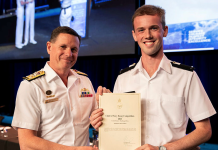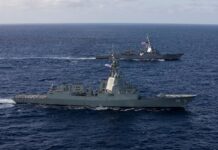 Australian submarine crews are safer than ever before after two weeks of rigorous but extremely successful exercises off the coast of Western Australia. In at times challenging weather conditions, JFD Australia, the world’s leading provider of submarine escape and rescue, partnered with the Royal Australian Navy to conduct the annual “Black Carillon” exercise which tests Australia’s submarine rescue system in a series of scenarios designed to replicate a real-life submarine rescue emergency.
Australian submarine crews are safer than ever before after two weeks of rigorous but extremely successful exercises off the coast of Western Australia. In at times challenging weather conditions, JFD Australia, the world’s leading provider of submarine escape and rescue, partnered with the Royal Australian Navy to conduct the annual “Black Carillon” exercise which tests Australia’s submarine rescue system in a series of scenarios designed to replicate a real-life submarine rescue emergency.
Importantly, the exercises demonstrated the world-class capability of the fully-integrated system that JFD provides to the Australian Government which includes a submarine rescue vehicle (a “mini” submarine with pilot and crew), a transfer-under-pressure chamber and a hyperbaric equipment suite to ensure that submariners receive the best possible medical treatment once they are back on the water’s surface.
A major element this year was a continuous ‘Rescue Exercise’ to test the complete system from the submarine rescue vehicle through to the transfer-under-pressure chamber where any initial triage of rescued submariners could be undertaken before moving to the new hyperbaric equipment suite.
Submarine rescue in a real emergency requires around the clock manning of the entire system and JFD worked seamlessly with the RAN medical team to achieve all excellent results.
“It is vital that our submarine rescue system can rescue and treat all personnel on board a Collins-class submarine and that is why these annual exercises involving the RAN, JFD’s 100-strong skilled workforce and our extensive supply chain are so critical,” said JFD Australia Managing Director, Toff Idrus (a former submariner). “This was the first Black Carillon where we have tested the entire rescue system and the first time we have deployed to sea three times in one year. These were some big milestones to achieve and I am delighted to say, we achieved each and every one of our goals.”
The RAN also commended JFD on a safe and highly successful Black Carillon.
“I was exceptionally impressed with what you achieved in the exercise and it was clearly evident that you had developed a strong sense of teamwork,” said Captain Geoff Wadley RAN, Commander Submarine Force.
“Speaking to international observers, they were unanimous in their praise for the exercise and the value they all got out of it, a job exceptionally well done.”
This year, using HMAS SHEEAN as the “target” submarine and together with rescue and intervention ships, MV STOKER and MV BESANT, JFD was able to conduct a series of simulated rescues in varying depths of water to demonstrate the flexibility and unrivalled range of its submarine rescue system.
Sheltered practices were successfully carried out in 20 metres of water (a key capability that is not available from other global submarine rescue providers), before moving on to mock rescues at depths of 135 metres with the remotely operated vehicle also diving in excess of 375 metres to simulate an inspection of a disabled submarine.
“In each stage of Black Carillon, it was important to demonstrate that our free-swimming submarine rescue vehicle and surface treatment systems could function no matter what the conditions,” said Mr. Idrus.
“Launching from a ship and diving down to locate a disabled submarine, connecting with its hatch and then safely transferring its crew to safety is what submarine rescue is all about.”



